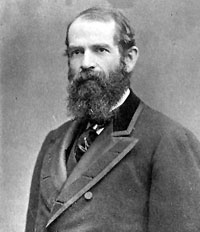
While we tend to think of these individuals as having been too busy to ever leave their New York offices, Jay Gould’s business activities of 1891 actually took him through the heart of Fannin County.
At the age of twenty-nine Gould, born Jayson Gould on March 27, 1836 in Roxbury, New York, started speculating in small railroads. By October 1867 he was a member of the board of directors of the Erie Railroad.
Before long he acquired the Erie, and later the Union Pacific, the Wabash, the Manhattan Elevated, the Burlington and other rail lines.
By 1879 Gould acquired many lines west of the Mississippi including the Denver Pacific, the Central Pacific and the Missouri Pacific. In 1881 he added the Texas & Pacific, the rail line that ran east-west across Fannin County, to his western holdings.
Throughout the 1880s Gould enjoyed the ups and endured the downs of his financial empire, especially his many railroad lines. By 1888, however, his health took a turn for the worse. His doctor diagnosed him with tuberculosis. Gould, described by one writer as being “[f]rail, soft-spoken and short of stature (little more than five feet tall),” knew that he had only a few years left.
As with other tuberculosis patients, Gould’s symptoms improved if he traveled to higher altitudes. So he left New York as often as possible and traveled west to see his railroad properties firsthand.
On at least two of these trips he inspected his Texas & Pacific lines in North Texas. His every move was telegraphed – understandably so since he also owned the Western Union Telegraph company – to various newspapers. Clippings show him in Texarkana, Marshall, Dallas, Fort Worth, Sherman and Denison in the spring of 1890.
The Dallas Morning News of April 15 reported: “Mr. Gould and party left the city yesterday morning over the Central railway at 8:15 o’clock for Sherman and Denison.” It further noted that Gould’s “special object was to take a view of the country since the recent rains. The party returned to Dallas at 7:10 last night and pulled out for headquarters at the fairgrounds side track.”
With reference to Gould’s physical well being, the News reported that “Mr. Gould’s health is not the very best.” It further stated that his personal physician, Dr. John P. Munn, was with him at all times.
After a few days in the North Texas area, Gould departed for the higher, drier climate of Denver.
Newspaper clippings make no mention of Gould visiting Bonham in 1890. However, 1891 would be a different story.
Jay Gould may have decided to inspect the northern transcontinental route of his Texas & Pacific Railroad - the line running roughly parallel to the Red River from Texarkana to Sherman before turning south towards Denton - in 1891 since he skipped the bulk of it in 1890.
The Dallas Morning News of April 11 reported that Gould and his party were in Paris at roughly eleven in the morning on April 10, and “were met at the Texas and Pacific depot by citizens and from there driven through the city.” It noted that it “was their first trip to Paris” and that “they were most agreeably surprised at the size of the city and magnitude of its business.” They further agreed that Paris had “the finest streets of any city in the country.”
The most interesting part of the article, however, was the next to last sentence, which read: “After the drive they left for the west.”
The west? If they stayed on the Texas & Pacific line, they were headed for Fannin County. It logically follows that they would stop in Bonham, the city that was the only divisional station, complete with turntable/roundhouse and other shops, on the T & P line between Texarkana and Fort Worth.
Dallas Morning News clippings, however, made no mention of Gould stopping in Bonham. It was time, therefore, to search out the Fort Worth papers. (Unfortunately, Bonham papers for 1891 are not available in any format.) Sure enough, The Fort Worth Gazette of April 11 carried a short piece about Gould stopping in Bonham.
However, before discussing Gould’s stop in Bonham, I will try, as best I can, to assist the reader in visualizing his trip through the eastern half of Fannin County.
It should be noted that Jay Gould did not travel in just any old passenger car. On the contrary, in 1888 he had a special, some say a palatial, car built just for him and his family for such trips.
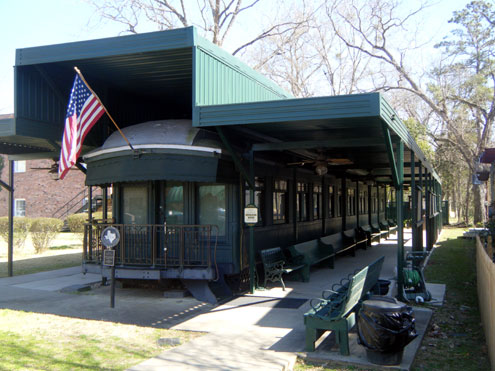
Dubbed the Atalanta (Gould also had a yacht by the same name), it was eighty-eight feet long, eleven feet wide with state rooms (i.e., personal rooms and sleeping quarters), restrooms, small kitchen, a dining area and luxurious sitting rooms with mahogany and curly maple walls. It was the definition of riding in style.
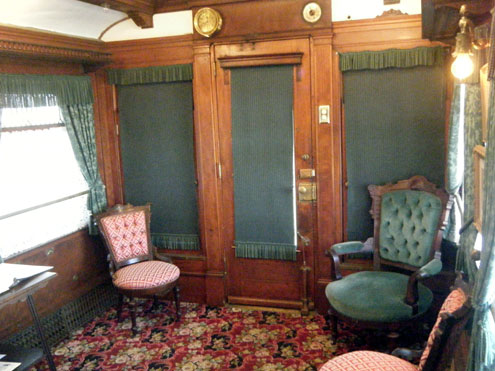
Referring to Gould’s preference for his private car, biographer Maury Klein notes: “Living aboard the Atalanta enabled him to orchestrate his contact with other people and afforded some relaxation.”
When in Dallas in the spring of 1890, the Dallas News of April 16 noted that Gould was in his prized private car. In light of that, it seems certain that he was aboard the Atalanta, now a major tourist attraction in the east Texas town of Jefferson, when he toured Fannin County and Bonham.
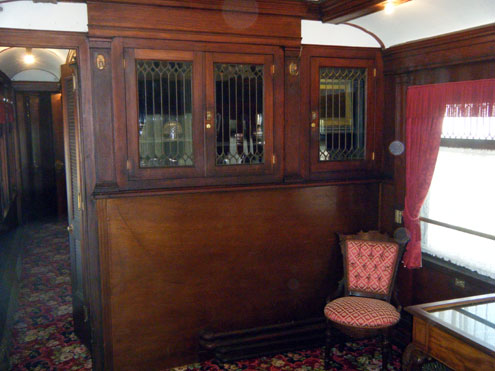
Imagine then, a belching steam locomotive pulling the Atalanta – the whole set up was described in the papers as a “special train” – through Honey Grove, Windom and Dodd City, topping and descending the big hill east of Bonham before slowly rolling to a stop at the depot.
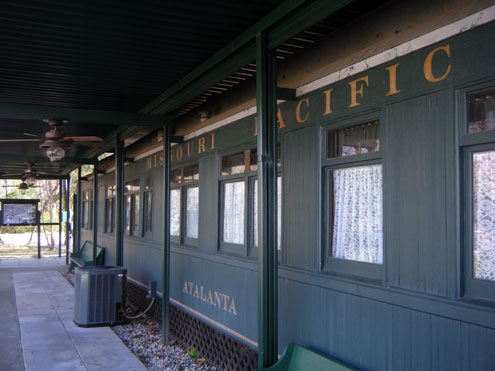
The Fort Worth Gazette clipping noted that once in Bonham, Gould and his retinue, which reportedly included George (son) and his wife, Howard (son), Dr. John P. Munn and others, “were met at the depot by a delegation of prominent citizens.” The Gould party was then “escorted by Capt. S. B. Allen, ex-president of the Fannin county bank and other prominent citizens . . . through the principal streets of the city.” It further noted that Gould said that “we had a fine town and the finest courthouse in the state, and that we only needed a few more public buildings of the same kind.”
The article concluded by saying that Gould and his party “remained but a short time and left for Dallas. It is thought that his visit means something with regard to Bonham’s railroad interests.”
It is worth noting that local railroad workers and their families may not have shared the enthusiasm for Gould’s visit. As historian Lawrence Goodwyn noted in his excellent The Democratic Promise: The Populist Moment in America: “Working conditions were particularly bad on the Gould railroads, where wages were sometimes withheld for two or three months.” When Texas & Pacific workers went on strike in 1886 protesting the working conditions, Gould broke the strike using brutal tactics.
One thing of particular interest in the Fort Worth Gazette article was Gould’s question as to “where the Denison, Bonham and New Orleans railroad [came] into the city and the present condition of the roadbed.” Interestingly enough, Jay Gould had a direct financial interest in the proposed rail line that Bonham and Denison leaders hoped would link their cities to one of the nation’s four largest ports, New Orleans. The exact nature of that financial interest will be covered in a future article since more research is needed.
Once through with his tour of Bonham, Gould’s “special train” rolled through the Fannin County countryside by way of Ector and Savoy. Since it was getting late in the day, no more stops were scheduled. Indeed, the April 10 Sherman Daily Register carried only a brief note stating: “Jay Gould and party passed through the city today. They were bound for Fort Worth.”
Jay Gould eventually made his way back to the center of his business universe, New York. By early March 1892, however, his health worsened again, and the Atalanta was readied for another trip out west. He ultimately was back in Colorado, and one biographer notes that by May “when the heat became uncomfortable, he relocated to the mountains near Pueblo.”
By midsummer he was back in New York. As summer faded into fall, Gould’s health worsened. On December 2nd he passed away. Telegraph wires flashed the story to newspapers across the country.
For at least a few folks in Bonham the news undoubtedly triggered conversations about that day, April 10, 1891, when they met and talked business with one of the Titans of Wall Street.
All photos of the Atalanta were taken by Tim Davis on a trip to Jefferson.
Thanks to the ladies at the Bonham Public Library for research assistance.